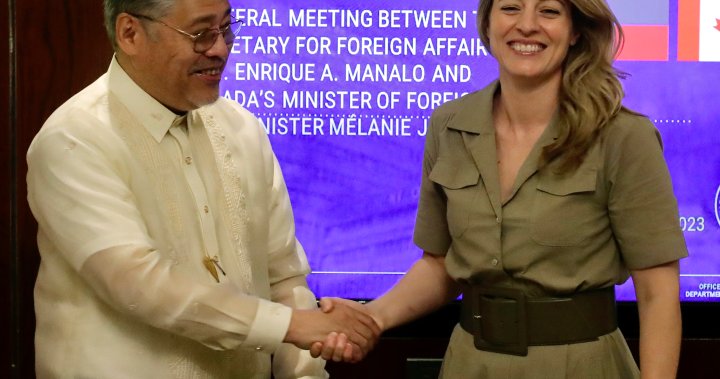The foreign minister of the Philippines wants closer business and military ties with Canada, saying the two countries can help maintain the post-war order in the Indo-Pacific by maintaining peaceful relations with both the U.S. and China.
“The future of our region should not be determined by the great power rivalry,” Enrique Manalo, the secretary of foreign affairs for the Philippines said in an interview last week.
“Today’s world is a lot different than it was after the Second World War, when you had a clear distinction between the West and the East. Now, you have a much more competitive world — and our relationships are more complex.”
Manalo visited Vancouver, Toronto and Ottawa this month to mark 75 years of bilateral relations, meeting with federal ministers for trade, immigration, aid and diplomacy.
His goal is to keep up the momentum that followed the Liberals’ release of their Indo-Pacific strategy in late 2022.
“Our relationship has really grown in the past two years, compared to where it was, let’s say, five or 10 years ago,” said Manalo.
His visit came amid heightened tensions between the Philippines and China over maritime boundaries.
A global court ruled in 2016 that Beijing’s claims over a large swath of the South China Sea lacked a legal basis, a finding the Chinese government disputes.
The Philippines sees that ruling as key to maintaining its sovereignty and securing income for fishers, Manalo said.
Vina Nadjibulla, the research vice-president for the Asia Pacific Foundation of Canada, said that the Philippines has a policy of publicly calling out any incident where it believes China is violating its territory, unlike some other Asian countries that tend to keep quiet.
Last week, the Philippines’ national security adviser called for Chinese diplomats to be expelled over the apparent leak of a phone call between military officials in both countries.

And earlier, in March, Chinese coast-guard ships hit a Philippine supply boat with water cannons near a disputed shoal, which Manila said caused injuries to its seamen and a wooden vessel.
The U.S. immediately called out Beijing for the confrontation, and Canada has similarly chided China for disruptions in the South China Sea.
Breaking news from Canada and around the world
sent to your email, as it happens.
Still, Manalo said the best way to manage relations with Beijing is by maintaining frequent contact with Chinese officials, which he said the Philippines is committed to despite recent tensions.
“It’s important to find ways and means to discuss these differences. And China always says that, so we have the same view,” he said.
He noted China is his country’s largest trading partner, with commerce dating back a millennium.
The Philippines doesn’t see China as an enemy, but rather a country that isn’t following what it agreed to in the 1994 global treaty governing ocean activities, known as UNCLOS.
“It boils down, really, to observing international law (and) the rules-based order,” he said.
Manalo said it’s crucial that both Washington and Beijing see themselves as partners to smaller countries, whose actions are neither “connected to their rivalry” nor intended to “support one of the powers or the against the other.”
That’s a message Foreign Affairs Minister Mélanie Joly could take to China if she makes a visit to the country, he said.
Last month, Ottawa sent the top civil servant from Global Affairs Canada to China. Such trips are sometimes organized ahead of visits by the Canadian foreign minister. There is no confirmation such a trip is in the works.
Canada’s Indo-Pacific strategy puts a focus on the Association of Southeast Asian Nations, a bloc of 10 countries that is seeing strong economic growth. Manalo said his fellow ASEAN countries generally don’t want to side with either Washington or Beijing.
Canada and the Philippines are “natural partners” that should work together more in fields such as agriculture, infrastructure, education and renewable energy, Manalo said.
Nadjibulla said the Philippines is “at the heart of” Canada’s regional strategy, and is “an anchor state” for Southeast Asia.
“If we want to deepen our economic as well as strategic relations with the region, the Philippines is the place where we have the greatest chance of making that happen,” she said.
In January, Ottawa and Manila signed a defence agreement on military training exchanges and disaster response.
A few months earlier, Canada agreed to help with “dark vessel detection,” or using technology to spot illegal fishing from boats that have turned off their transmitters.
Nadjibulla said it’s “really important” that Trudeau solidify the relationship by attending ASEAN’s annual summit in Laos this October, after taking part in the past two years’ meetings.
She also said Canada should consider joining Japan, Australia and the U.S. in regional joint military exercises, to discourage Beijing from breaching international treaties.
Manalo noted the size of the Filipino diaspora in Canada — some 925,000 people, according to the 2021 census — and said common challenges are arising from the fact “our world is getting smaller.”
Yet the Philippines is rarely on Canadians’ radar, despite the country having strong economic growth and a favourable view of Canada, in part due to the longtime presence of Canadian insurance firms such as Sun Life and Manulife.
The State of Southeast Asia survey ranks Canada as second-last for relevance among the 11 countries with whom ASEAN has a formal partnership, according to polling of 2,000 people across the region in January and February by the Yusof Ishak Institute in Singapore.
Filipino respondents bucked the trend by ranking Canada as the seventh most-important country.
Manalo’s visit follows a pair of meetings between Trudeau and Philippine President Ferdinand Marcos Jr. and other cabinet-level visits.
It’s a marked change in tone from Trudeau’s 2017 meeting with former president Rodrigo Duterte, who didn’t appreciate the Canadian prime minister chastising him over the country’s violent war on drugs.
Manalo suggested Ottawa seize the current momentum to get Canadian corporations more active in the Philippines, and then expand to neighbouring countries.
“Canada now has a basis to really project its influence in the Philippines and in the region as whole.”





